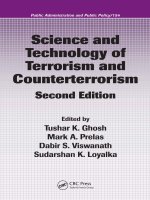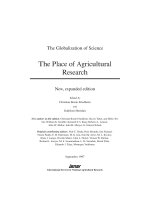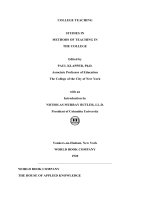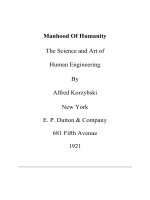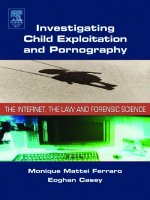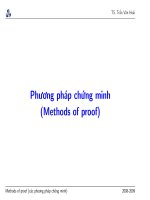- Trang chủ >>
- Đại cương >>
- Kinh tế vĩ mô
forensic science modern methods of solving crime
Bạn đang xem bản rút gọn của tài liệu. Xem và tải ngay bản đầy đủ của tài liệu tại đây (1.39 MB, 187 trang )
FORENSIC SCIENCE
Modern Methods of Solving Crime
Max M. Houck
Library of Congress Cataloging-in-Publication Data
Houck, Max M.
Forensic science : modern methods of solving crime / Max M. Houck.
p. cm.
Includes bibliographical references and index.
ISBN 978–0–275–99323–8 (alk. paper)
1. Forensic sciences. 2. Criminal investigation. I. Title.
HV8073.H76 2007
363.25—dc22 2007000060
British Library Cataloguing in Publication Data is available.
Copyright ª 2007 by Max M. Houck
All rights reserved. No portion of this book may be
reproduced, by any process or technique, without the
express written consent of the publisher.
Library of Congress Catalog Card Number: 2007000060
ISBN-10: 0–275–99323–X
ISBN-13: 978–0–275–99323–8
First published in 2007
Praeger Publishers, 88 Post Road West, Westport, CT 06881
An imprint of Greenwood Publishing Group, Inc.
www.praeger.com
Printed in the United States of America
The paper used in this book complies with the
Permanent Paper Standard issued by the National
Information Standards Organization (Z39.48–1984).
10987654321
This book is dedicated to all of the students in my courses at West Virginia
University who deserve sincere thanks for helping me understand,
reduce, and refine the fundamentals of what forensic science is. Students
are always the best teachers—that’s my story and I’ll stick by it.
Contents
Preface ix
Acknowledgments xv
Important Moments in the History of the Forensic Sciences xvii
1 History 1
2 The Nature of Evidence 33
3 Pathology 49
4 Fingerprints 63
5 Trace Evidence 77
6 DNA 103
7 Firearms 117
8 Anthropology 125
9 Expert Testimony 145
Notes 153
Index 159
Preface
In the “Introduction to Forensic Science” course I teach at West Virginia
University, I try to jog the students’ minds from their preconceptions,
especially about the forensic sciences. I explain how forensic science is a
historical science, like geology, archaeology, or astronomy, and forensic
scientists reconstruct past criminal events through physical evidence. This
reconstruction requires an interpretation or telling of the events (a “strong
narrative”) and this, in turn, requires a grammar. If nouns are the sources
of the evidence (guns, sweaters, bodies, etc.), the bits of evidence found at
the scene or on the victim are pronouns (representing as they do the
subjects or objects, i.e., nouns or evidence), and the criminals’ actions
themselves are the verbs. Adjectives and adverbs come infrequently to
forensic interpretations unless they are bound within the factual descrip-
tion of the evidence—portions of snapshots, frozen partial views of the
past criminal events. A perfect reconstruction of a crime scene would be
an infinitely detailed video, capable of being enhanced, reviewed, and
reanalyzed at the whim of the investigating scientist. Forensic science
does not get evidence like this, not even video evidence. The “partial
snapshot” analogy encourages them to consider what can and cannot be
said after a forensic analysis—it encourages conservatism. It also frames
the students actions themselves are the verbs. Adjectives and adverbs
come infrequently to forensic interpretations unless they are bound
within the factual description of the evidence—portions of snapshots,
frozen partial views of the past criminal events. A perfect reconstruction
of a crime scene would be an infinitely detailed video, capable of
being enhanced, reviewed, and reanalyzed at the whim of the investi-
gating scientist. Forensic science does not get evidence like this, not
even video evidence. The “partial snapshot” analogy encourages them to
consider what can and cannot be said after a forensic analysis—it
encourages conservatism. It also frames the students view of forensic
science outside the traditional perspective and they realize they can
play with ideas a bit more than they might have otherwise considered.
They understand there are things you can and cannot say in forensic
science and perhaps also understand why the rules of grammar need
to be bent at times. Forensic science is now something other than the
media-colored perception with which they started class (M.M. Houck,
“CSI: Reality,” Scientific American [2000]: 84–89).
A drug chemist once argued with me that what my students did was
not a “historical science,” as I teach my students, because they performed
chemical analyses on the suspected illicit drug samples and were not
involved in a reconstruction. The substance either was cocaine or not
and that was the end of their concern in the matter. Fair enough, as far
as that argument goes. But to what end is the chemical analysis being
performed? Surely not for the pure joy of chemistry alone. The analysis is
done to support or refute the allegation that a person was found with an
illegal substance in their possession. Read that sentence again. You prob-
ably slipped past the two most important words in that last sentence: was
found. Possession of cocaine ostensibly indicates a past criminal act and the
chemist, whether he or she acknowledges it or not, is assisting in the
reconstruction of that event.
A bit of explanation about this grammar thing may be necessary.
When two things come into contact, information is exchanged. This
is one of the central guiding principles of forensic science. Developed
by Edmund Locard, it posits that this exchange of information occurs,
even if the results are not identifiable or are too small to be found.
The results of such a transfer would not be the transfer itself, but
the remnants of that transaction, what paleoclimatologists call proxy
data. Proxy data that are collected and analyzed by forensic scientists
are evidence; if these are not collected or analyzed, they can hardly
help to make a proposition more or less likely. Otherwise, these are just
proxy data left at the scene of the crime. This is why I call evidence
“pronouns”: we rarely examine the thing itself for itself but examine
either bits of it that have transferred or something transferred to it that
represents the source. Pronouns stand in for nouns and through the
context of a sentence we know which “it” or “he” stands for the “toaster”
or “John.”
Because forensic science demonstrates associations between people,
places, and things, essentially all evidence is transfer evidence. The following
table lists some examples in support of this concept. All evidence comes
from a source and ends up on a target; in this sense, all evidence is
transferred.
x Preface
Not all forensic scientists would agree with this view; nontrace evi-
dence analysts would be among the first to disagree. But it makes sense to
my students, who are something of a tabula rasa when they come in
(television notwithstanding). In working toward a unified theoretical
basis of forensic science, we must be willing to collapse categories as
well as to expand them.
Another idea that may not be self-evidenct: Evidence is accidental. Items
are transformed into evidence by their involvement in a crime regardless
of their source or mode of production. No factories churn out bloody
clothing or spent bullets. By becoming evidence, everyday items have
their normal meaning enhanced and expanded. Evidence is initially cate-
gorized much like the real world; that is, based on the taxonomy created by
manufacturers (e.g., optical glass vs. bottle glass) or devised by natural
scientists (shale vs. wollastonite, finches vs. pigeons—including subtypes).
Forensic science adds to this taxonomy to further enhance or clarify the
meaning of evidence relevant to the goals and procedures of the discipline.
Forensic science’s taxonomies, while based on production taxonomies,
are nevertheless different from them. Manufacturing of economic goods,
for example, creates its taxonomy through analytical methods. Standard
methods ensure a quality product fit for purpose and sale. The taxonomy
is based on the markets involved, the orientation of the company produc-
tion methods, and the supply web of raw and processed materials.
Item
Transferred From
(Source)
Transferred To
(Target/Location)
Drugs Dealer Buyer’s pocket or car
Bloodstains Victim’s body Bedroom wall
Alcohol Glass Drunk driver’s bloodstream
Semen Assailant Victim
Ink Writer’s pen Stolen check
Handwriting Writer’s hand/brain Falsified document
Fibers Kidnapper’s car Victim’s jacket
Paint chips/smear Vehicle Hit-and-run victim
Bullet Shooter’s gun Victim’s body
Striations Barrel of shooter’s gun Discharged bullet
Imperfections Barrel-cutting tool Shooter’s gun’s barrel
Preface
xi
Explicit rules exist on categories recognized by manufacturers and
consumers: McDonald’s versus Burger King, loafers versus oxfords,
Windows versus Macintosh.
Forensic analytical methods create different taxonomies, however,
because forensic scientists have different goals and this requires the use
of different methods. Their taxonomies are based on manufactured or
class traits, but also aftermarket qualities, intended end use but also “as
used.” The “as used” traits are those imparted to the item after purchase
either through normal use or criminal use. Forensic science has developed
a set of rules through which the taxonomies are explicated. For example,
forensic scientists are interested in the size, shape, and distribution of
delustrants—microscopic grains of titanium dioxide—incorporated into a
fiber to reduce its brightness. The product determines the goal; ball gowns
should be shiny, carpets should not be. The manufacturer has included
delustrants in the fiber at a certain rate and percentage with no concern for
shape or distribution (but size may be relevant). The forensic science
taxonomy is based on the manufacturing taxonomy but is extended by
incidental characteristics that help us to distinguish otherwise similar
objects. A heavily delustered fiber may have large or small granules;
they may be evenly distributed or clumped together; they may be round
or irregular, and so on. The fiber manufacturer could not care less but the
forensic scientist cares a great deal.
P.W. Bridgman once wrote, “The concept is synonymous with the
corresponding set of observations” (The Logic of Modern Physics, 1932,
New York: Macmillan Publishers, 5).
Although terse, this phrase is apt for forensic science. Each measure-
ment taken and each observation made are indications of the conceptual
principles that support a science. So it is with forensic science—refractive
index is useful to an analysis precisely for the reasons it is used: It helps to
discriminate between materials. Of course, my bias is evident: I see trace
evidence as embodying the essence of forensic science. Perhaps it is not
bias, however, but merely the proper viewpoint. After all, “only Nixon
could go to China,” and maybe what is required to point out the bare
philosophical underpinnings of our discipline are the people closest to it’s
guiding principle. Trace evidence gets short shrift in many of today’s
forensic laboratories, especially struggling in the shadow of its younger,
more popular sibling, DNA.
I hope this book brings a fresh view of forensic science to you, one
that is not tinged by accusations of inept practitioners, wildly dramatic
television shows, or the rhetoric of attorneys. It is a fascinating field
xii Preface
and one that is still in many ways maturing from its adolescence in police
agencies. The view I offer will, I hope, spur you to support forensic science
in its growth and development as an integral part of the criminal justice
system.
MMH
Preface xiii
Acknowledgments
Thanking people is a nicety we ignore too often. Writing takes time,
solitude, and doggedness; this, in turn, requires the indulgence of people
who invest in and count on your presence. Thanks are due to those
individuals whose time I have stolen or who have invested in me so that
I may steal that time: My wife, Lucy; my father, Max; my staff at the
Forensic Science Initiative (Mary, Robin, Samantha, Anna, Emily, Ryan,
Marlene, and Shiela); my agent Jodie; and Suzanne Staszak-Silva (we
tried). Finally, thanks to you for reading this book.
